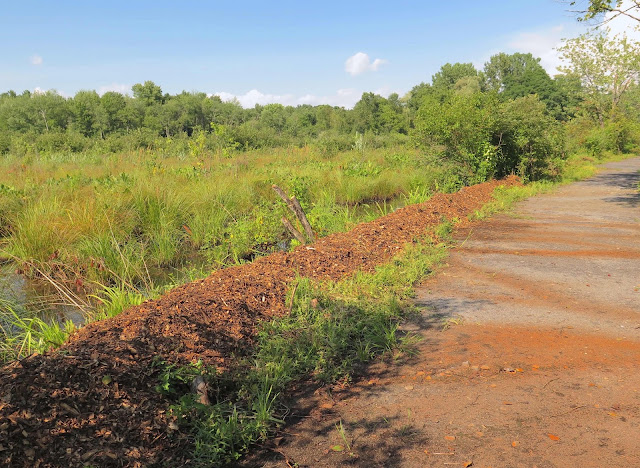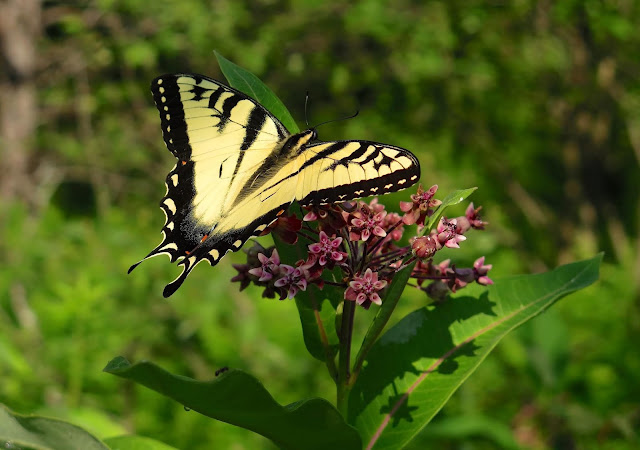Along the Riverbanks
The weekend's terrible heat was gone, with temps today (Tuesday) in the comfortable high 70s. Monday's all-day rain and chill had moved along, and today was sunny and pleasant. A perfect day to paddle the beautiful Hudson River at Moreau.
As I moseyed along close to the forested banks, pink puffy clusters of Meadowsweet (
Spiraea alba) hung over the water.
Higher up on the banks I could see the yellow flowers of Spotted St. Johnswort (
Hypericum punctatum), but it required the zoom lens of my camera to let me see the spotted petals of this native wildflower.
The gracefully arching dark-green leaves of Pearly Everlasting (
Anaphalis margaritacea) were even more lovely than the wooly tight nubs of its flowers.
I was hoping to maybe find the elusive Small Purple Fringed Orchid (
Platanthera psycodes) along these banks today, but not really counting on it, since this orchid seldom appears in the same place I'd found it before. But there it was! And not to be missed, with that huge inflorescence, fully in flower, each floret wide open, from the bottom to the top! What a regal looking orchid! Spectacular!
This orchid's flowering stalk was so much larger than any
P. psycodes I'd ever seen, I wondered if it might be instead the Large Purple Fringed Orchid (
Platanthera grandiflora). I beached my canoe to take a closer look at its florets.
I had been told that the easiest way to tell these two orchids apart is to compare the opening to the spur. In the case of
P. grandiflora, the opening will be round. But the opening in this orchid was horizontally rectangular, which means that this orchid really IS
P. psycodes, the Small Purple Fringed Orchid -- albeit a very
large Small Purple Fringed Orchid.
Just a little further along the bank, I came upon two more Small Purple Fringed Orchids, with inflorescences quite a bit smaller than that of the first one I had found, and with only the lower florets fully open, with buds still closed toward the top. These two were the size and shape I was used to seeing for this species.
Here was another treat that awaited me on these riverbanks today. This little Waterthrush came running along the shore, hopping over fallen branches and constantly tipping its pale-colored rump up and down as it ran.
At first (because of all that tail bobbing) I thought it might be a Spotted Sandpiper, but it seemed much too short and chubby for that. Luckily, my camera zoom can see much better than my eyes can, so I was able to detect the stripe above the eye and the streaky breast and sides that convinced me it must be a Waterthrush. Unfortunately, I didn't get a clear-enough photo to help me determine whether it was a Northern Waterthrush or a Louisiana Waterthrush.
UPDATE: I have since heard from two birders who told me that this is more likely the Louisiana Waterthrush. They cited the habitat (moving water rather than marsh or bog) and markings (widely spaced stripes and lack of buff coloring) as reasons to eliminate the other possibility.
The day was still young, so I still had time to check out some plants on a nearby high powerline before going home. I headed to shore, but the serene loveliness of the river, with forested banks and mountains rising on both sides, made it hard to leave. I rested my paddle and let the slow current carry me back to the launch site.
Up a Mountainous Powerline
I hope soon there will be well-groomed trails up to this mountain height, for the powerline clearcut I climbed today bisects some new lands acquired by Moreau Lake State Park this past year. I've seen photos of beautiful overlooks that the new trails are promised to lead us to, but today I was content to enjoy a glimpse of the river's blue water off in the distance, and the long view of the powerline as it snaked across the riverside hills.
Turning around, I could see the powerline climbing, climbing, climbing, and then disappearing over the top. I've never attempted to reach the summit of this clearcut, since in about 3 sets of pylons further up, the rocks become steep and precipitous, too risky for me with my feeble damaged knee to attempt.
Today I was happy to wander a lower meadow, especially since it was made astoundingly beautiful by the huge vivid-purple blooms of Pasture Thistle (
Cirsium pumilum) and the more slender spikes of rosy-pink Steeplebush (
Spiraea tomentosa).
The Pasture Thistle bears fragrant flowers nearly as big as my fist. Also, it seldom grows more than hip high, so it is easy to contemplate its beauty from above.
The spiky-looking hemispheres that contain the bracts of Wild Basil (
Clinopodium vulgare) look as prickly as thistle leaves, but they're really not prickly at all. They persist long after the the pinky-purple florets have dropped, looking like interesting blooms in their own right.
There are sheets of exposed bedrock up here on this mountainside, just the kind of habitat Pale Corydalis (
Capnoides sempervirens) thrives on. I was happy to see a few of its yellow-tipped, bright-pink flowers still in bloom today.
As its name suggests, Deptford Pink (
Dianthus armeria) possibly came to North America from the town of Deptford in England, so it can't be called a native American wildflower. But it sure is a pretty little thing, and it's hardly invasive, since I always find it surrounded by native plants like Bushclovers and Black-eyed Susans, as it is on this mountainside.
Well, darn! Missed it again! I keep trying to catch this tiny Orange Grass St. Johnswort (
Hypericum gentianoides) in bloom, and I always come looking either too early or too late. I could see the green grass-fine stems were tipped with tiny yellow buds, but no sign yet of a flower. The buds look as if they might open any day, so I guess I should try to come back next week and see if they flower then. But hey, it's not an easy stroll to make it up here to visit them. Unfortunately, this clearcut is the only place I have found this plant in all of the places I prowl in Saratoga County.
My disappointment regarding the Orange Grass, however, was quickly dispelled by the appearance of this beautiful American Lady butterfly. Happily, it found lots of what it was looking for in the flowers of this Wild Marjoram (
Origanum vulgare), so I could snap photo after photo after photo, hoping to capture one of the microseconds it held its wings open for the picture-taking. I'm happy I was able to photograph the open wings, for that allowed me to see the tiny white dot on the forewings and the blue-centered eyespots on the rear ones, features that distinguish this butterfly from its almost-identical look-alike, the Painted Lady.
I believe these amorous butterflies are Eastern Tailed Blues, even though I can't see the "tails" extending from the wings. But I sure can see the orange dots that distinguish this butterfly from other small blues like the Spring Azure or Summer Azure or Karner Blue.
There were many insects soaring or flitting about on this sunny day, but most were too active for me to get clear photos of them. But this female Calico Pennant dragonfly kept returning again and again to the same twig of Sweet Fern, so I bided my time, creeping ever closer with camera focussed and HAH! I got the shot! Isn't she lovely, decorated with brilliant yellow in all the same places her mate is colored red, including the lacy veins of her wings!
Here's another couple -- a pair of Long-horned Flower Beetles -- who ignored my intrusive camera lens, occupied as they were with other important matters. What a beautiful love nest they had, on top of a flower of Queen Anne's Lace.
Time to go home. I found it harder to climb down this mountainside than I did climbing up it. My injured knee gets tired climbing up, but it positively wobbles when it has to lower me down. This pretty patch of Steeplebush, so nicely set off by the shade of the bordering woods, reveals the steepness of the descent. I am eager for the park to lay some new trails through this property, hopefully ones that will make this mountain a bit more comfortable to climb. There are many more beautiful native wildflowers up here that have yet to come into bloom, so I'm planning to return.

















































